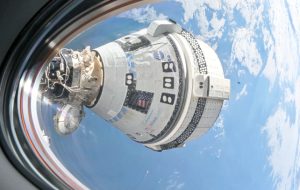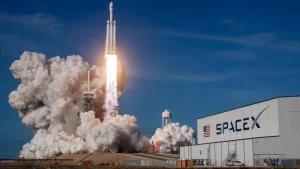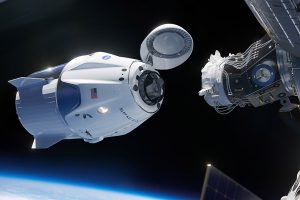NASA May Use SpaceX Spacecraft to Rescue Stranded Astronauts
NASA has revealed potential plans to utilize SpaceX’s spacecraft as a means of saving astronauts who may find themselves stranded in space. With the extensive progress SpaceX has made in the realm of space exploration, the company’s spacecraft have been identified as viable solutions for such rescue missions. This development underscores the increasing collaboration between the two entities, with SpaceX becoming a pivotal player in NASA’s future endeavors.
It has been suggested that in the event of a mishap in space, where astronauts are left stranded, NASA could deploy SpaceX’s Dragon spacecraft to retrieve them. The Dragon spacecraft has demonstrated its reliability and efficiency in transporting astronauts to and from the International Space Station (ISS), making it a suitable choice for these emergency scenarios. The spacecraft’s advanced technology, including its state-of-the-art docking system and its ability to autonomously operate in space, can ensure a safe and efficient rescue mission.
SpaceX’s spacecraft are also equipped with life-support systems to maintain a habitable environment, ensuring the astronauts’ safety until they can be returned to Earth. Furthermore, the Dragon spacecraft’s reusability could potentially lower the costs associated with such rescue missions.
This possibility is not without challenges, however. Space rescues are inherently high-risk operations that require precise execution. Any mission would need to be meticulously planned and coordinated, taking into account the location of the stranded astronauts, the condition of their spaceship, and other factors that could hinder a successful rescue. The safety of the rescuers would also need to be paramount in any potential operation.

Moreover, these rescue missions may necessitate changes to SpaceX’s current spacecraft designs. For instance, the Dragon spacecraft typically carries a maximum of four astronauts. In a rescue mission, it may need to accommodate more individuals. This could require additional space, supplies, and life-support systems, modifications which would need to be developed and tested before any rescue mission could be carried out.
Additionally, the potential of SpaceX’s spacecraft being used in rescue missions highlights the broader implications of the public and private sectors working together in space exploration. This partnership brings together NASA’s decades of space exploration experience and SpaceX’s innovative technology, potentially leading to new advancements in the field. It also opens up the possibility of other private companies collaborating with government agencies in future space efforts.
In conclusion, the potential use of SpaceX’s spacecraft for rescuing stranded astronauts showcases the increasing role of private companies in space exploration. While such missions pose significant challenges, the benefits they could bring – from saving lives to advancing technology – make them a promising avenue for future collaboration between NASA and SpaceX. Although still in the realm of possibility, this development signifies an exciting step forward in space exploration, demonstrating the potential of combining public sector experience with private sector innovation.
SpaceX’s Role in Astronaut Rescues
SpaceX, the pioneering private space exploration company led by Elon Musk, plays a critical role in astronaut rescures. Traditionally, astronauts have relied on government space agencies like NASA or the Russian Space Agency for their safety and rescue operations. However, SpaceX’s emergence as a significant player in space exploration has seen it take on a more active role in ensuring the safety of astronauts. This responsibility was highlighted in the company’s first manned mission, the Crew Dragon Demo-2, where the company had to demonstrate its ability to safely transport astronauts to and from the International Space Station. As part of this mission, SpaceX had to show its capacity to handle emergency situations, including the potential rescue of astronauts.
SpaceX developed an advanced abort system for the Crew Dragon capsule that can jettison the astronauts to safety in the event of a launch failure. The company also put a recovery ship, staffed with SpaceX’s own trained recovery team, on standby in the Atlantic to recover the astronauts. The success of this mission demonstrated SpaceX’s ability to handle astronaut rescues, marking a significant step forward in the commercialization of space travel. Furthermore, SpaceX’s role in astronaut rescues extends beyond just their own missions. They have also provided support and resources to NASA for the Orion spacecraft’s Ascent Abort-2 flight test, which is designed to ensure astronaut safety during ascent to space. This collaboration highlights SpaceX’s commitment to the safety of space travel and its role as a leader in developing astronaut rescue capability.
The Potential of Rescue Dragon for Space Missions
Rescue Dragon, a spacecraft developed by SpaceX, holds immense potential for space missions, especially those that involve the rescue and recovery of astronauts in distress. The spacecraft’s design includes a highly efficient life-support system, which ensures the safety and survival of the crew members during any unforeseen mishaps in space. In particular, the spacecraft’s ability to autonomically dock and undock with the International Space Station (ISS) underscores its utility in emergency situations. The Rescue Dragon is also equipped with propulsion capabilities that can facilitate a deorbit burn and reentry into Earth’s atmosphere, and its advanced parachute system ensures a soft water landing.

The spacecraft’s robust construction and features, combined with SpaceX’s extensive experience in reusable spacecraft, make it exceedingly reliable and cost-effective compared to traditional space rescue vehicles. As the landscape of space exploration continues to evolve, the Rescue Dragon is poised to play a crucial role in ensuring the safety and success of future missions. Its sophisticated technology and capabilities, paired with its versatility and resilience, make it a valuable asset in the development of space travel and exploration. Therefore, the potential of Rescue Dragon for space missions is not only significant but also indicative of the progress being made in space technology. Its deployment in future missions could potentially revolutionize the way we approach space rescue and recovery, ultimately safeguarding the lives of those who dare to venture into the great unknown.
How SpaceX Could Assist in Astronaut Rescues
SpaceX, led by visionary Elon Musk, has the potential to play a significant role in astronaut rescues, thanks to its advanced technology and pioneering work in private space exploration. The company’s Dragon spacecraft, for instance, is designed to carry up to seven passengers to and from Earth’s orbit, and even beyond. As this ship is reusable, it can be launched, landed and relaunched, which could be invaluable in an emergency scenario involving astronauts in distress.
SpaceX’s Falcon rockets could also be instrumental in astronaut rescues. With the ability to deliver payloads to space and return back to Earth, these rockets could potentially be used to carry rescue equipment or additional personnel to a spacecraft in trouble. Furthermore, the Falcon Heavy, SpaceX’s most powerful rocket, could potentially undertake rescue missions in deeper space, given its ability to carry considerable weight and travel further than any other operational rocket.
In addition to their vehicles’ capabilities, SpaceX’s ground-breaking advancements in technology could also aid in astronaut rescues. Satellite technology can provide essential communication links between astronauts in distress and rescue teams, helping to coordinate emergency responses and relay vital information.
Moreover, SpaceX’s plans to colonize Mars demonstrate their long-term commitment to space exploration. This vision underlines the importance of developing robust and effective astronaut rescue capabilities. While hoping never to use them, the preparation for such scenarios is crucial.
However, it’s important to note that conducting a rescue mission in space is an extremely complex task, requiring precise planning, coordination and execution. It also involves significant risks. Despite these challenges, SpaceX’s technological capabilities, combined with their innovative approach to space exploration, could make them a key player in the field of astronaut rescues. Their pioneering work could help shape the future of safe space travel, making the cosmos a little less daunting for those brave enough to explore it.
The Current Situation of the Stranded Astronauts
The current predicament of the stranded astronauts is a subject of immense international concern. These courageous explorers, who ventured into the vast expanse of the cosmos, are currently trapped on Mars due to unforeseen technical issues with their spacecraft. The situation is dire as the life-supporting supplies, necessary for their survival, are dwindling at an alarming rate. The astronauts, despite their rigorous training and mental fortitude, are grappling with the psychological toll of isolation and uncertainty. Communication with Earth is possible, albeit delayed, adding an extra layer of difficulty to the rescue efforts.
NASA, along with other international space agencies, is working tirelessly to devise a plan that could potentially rescue these stranded pioneers. The main challenge lies in the considerable distance between Earth and Mars, making it impossible to carry out a swift rescue mission. The scientific community has suggested various solutions, including sending an unmanned resupply mission or utilizing the existing resources on Mars to prolong their survival until a fully-fledged rescue can be executed.
Public sentiment surrounding this predicament is a mixed bag of fear, sympathy, and admiration. The world watches with bated breath, as the drama unfurls millions of miles away. However, the astronauts’ plight has also sparked a renewed interest in space exploration, with many acknowledging the need for advanced technology and robust contingency plans. The global community has rallied together, transcending borders and differences, to support the stranded astronauts in their time of dire need. This incident, while alarming, serves as a stark reminder of the inherent risks associated with space travel and the indomitable human spirit that continues to push the boundaries of the final frontier. Despite the odds, there remains a glimmer of hope that the astronauts will return home safely, turning this daunting experience into a testament of human resilience and scientific achievement.

Technical Aspects of Using SpaceX Spacecraft for Rescue
The utilization of SpaceX spacecraft for rescue operations introduces several technical aspects that need to be considered. First, the design and engineering of the spacecraft are crucial to ensure the safety and survival of the rescue team and the individuals being rescued. The spacecraft must be equipped with advanced navigation systems, life-support systems, and robust communication tools. The Dragon capsule, for instance, has autonomous docking capabilities, which could be vital during a rescue mission where precision and timing are critical.
Moreover, the spacecraft must be able to withstand harsh space conditions and extreme temperatures. The heat shield technology used on SpaceX’s spacecraft, like the Starship, is designed to handle intense heat during re-entry into the Earth’s atmosphere. This would be essential in a rescue scenario to ensure the safe return of all individuals onboard.
In addition, fuel efficiency and reusability are other technical aspects to consider. SpaceX’s spacecraft are powered by Raptor engines, which use liquid oxygen and methane as propellants. These engines are not only powerful but also designed for multiple uses, making them cost-effective for repeated rescue missions.
Moreover, the spacecraft’s capacity is another crucial factor. The Dragon capsule can carry up to seven passengers, while the Starship has a much larger capacity, able to transport up to 100 people at once. This means that in a large-scale rescue operation, the Starship would be more suitable.
Finally, the technical competence of the crew is pivotal. Operating a spacecraft requires specialized skills and training. In a rescue mission, the crew must be equipped to deal with emergencies, including medical emergencies, that may arise during the mission. Therefore, comprehensive training programs need to be in place for the crew members involved in such operations.
In summary, the technical aspects of using SpaceX spacecraft for rescue involve considerations around the spacecraft’s design, durability, fuel efficiency, capacity, and the expertise of the crew. All these factors contribute to the feasibility and effectiveness of conducting rescue missions in space.
